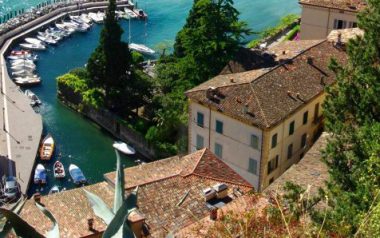Palace Fioravanti
Characteristic architectural elements of the XV-XVI-XVII centuries that are found along the buildings of the historical center of one of the centers of the Italian Riviera Magnifica Patria
Palace Fioravanti: (XVI century) It is the first palace that meets down to the port of Toscolano and the oldest of the three palaces, probably built at the end of the XVI century. Beautiful imposing building (now disfigured by a wooden overpass) that has as particular interesting those shelves under the windowsills of the upper floors and the grand stone portal. Triple rusticated bands rise and turn to form the arch and support the beautiful trabeation of Renaissance flavor. A bearded mask, well carved on the key of the bow and another on the first band were engraved in two different periods, overlapping with the motto. The oldest, in imperial writing of the sixteenth century, says: DEUS NOBIS HAEC OTTA FECIT; the second, with a less elegant engraving perhaps from the eighteenth century, was written on two lines: “MELIUS BONUM NOMEN QUAM DIVITIAE MULTAE” (perhaps an envious of the rich neighbors) and, on the other side, “FUNICULUS TRIPEX DIFFICILE RUMPITUR”. In the interior, as it seems that even for the past it was not finished or at least adorned, everything has been rebuilt modernly and therefore there is no remarkable thing. Toward the lake, the whole ground floor is hidden by a recent, horrible front part already used as a warehouse and now abandoned. On the first floor, a small loggia with seven lowered arches and Tuscan columns, now walled up. On the second, an arched door gives onto a long balcony, the railing of which is of very poor design; on the sides, two pairs of windows of different width. The only element that has been saved from so much destruction is the terminal cornice, with simple curved brackets.
Palace Fioravanti – Historical sources Fausto Lechi, “Dimore Bresciane, in cinque secoli di storia”

